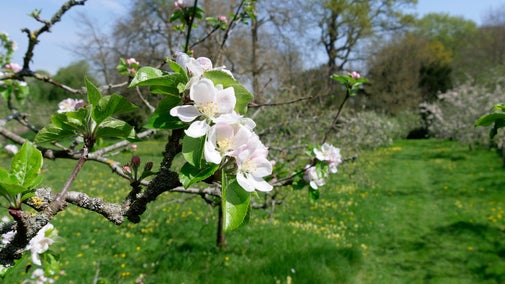
Lacock Abbey's collections
Explore the objects and works of art we care for at Lacock Abbey on the National Trust Collections website.

Three collection items from Lacock Abbey were chosen to celebrate 125 years of the National Trust. Specialist curators carefully chose from the many objects across the country. Find out which three treasures from Lacock Abbey were selected for inclusion in the specialist collections publication containing 125 items from the nationwide collection.
We know very little about the everyday world of the nuns at Lacock Abbey. However, one of the most important books in the collection gives a remarkable and rare glimpse into how they might have lived their lives.
The book, Expositiones Vocabulorum Bibliae, was written by William Brito – sometimes known as Guillaume le Breton – in the 14th century. Written in Latin on parchment, it's an alphabetical list of difficult words in the Bible, giving explanations, origins and etymologies.
The book, which is handwritten in several different hands, was rebound using 13th-century parchment scraps from the Abbey’s financial accounts. Those fragments record both expenses and receipts, including the sale of wool. This was an important trade in Lacock and provided an income for the abbey.
It's one of very few monastic books to survive the Dissolution of the Monasteries under King Henry VIII in the 1530s and still be in its original location – the others are all in cathedral libraries. The Brito was brought back to the abbey after the National Trust acquired it at auction in 2011.
When Lacock Abbey became a private home after the Dissolution of the Monasteries, its Tudor owner was keen to show off his wealth and sophistication. Sir William Sharington extensively remodelled the former nunnery and commissioned a distinctive stone table to fit his new octagonal tower.
This table is the centrepiece of the tower’s middle storey, or ‘Strong Room’, a place to display treasured objects and to study.
The decorative Purbeck marble top is shaped as an octagon to mirror the shape of the tower. The table top is supported by four crouching, leering satyrs (half-man, half-goat), who balance baskets of fruit upon their heads.
Standing on a cross-shaped base, they're carved from a hard-wearing oolitic limestone.
The table is attributed to the stone carver John Chapman. Chapman worked for the leading figures of the Protestant regimes of King Henry VIII and Edward VI, including Sir John Thynne (c.1515-80) at Longleat estate, also in Wiltshire.
You can view the table from all sides thanks to its unique position in the octagonal tower. Look out for the initials of the owner hidden within the distinctive scorpion-shaped badge.

The first half of the 19th century was a time of great scientific innovation. A puzzle that fascinated academics and scientists was whether it was possible to create an image, other than by the traditional methods of drawing and painting.
William Henry Fox Talbot lived at Lacock Abbey and created the earliest-surviving photographic negative in 1835. He refined and perfected a process of photographic reproduction known as a calotype.
The calotype invention used a sheet of paper coated with silver chloride, which was exposed to light in a camera obscura. The areas hit by light became dark in tone, producing a negative image.
What’s so inventive about this process is that, from the one negative, multiple positive images could be made. The new process was shared and enthusiastic amateurs followed in Fox Talbot's footsteps.
We don't know who took the calotype of Ham House in Surrey that enabled the making of this positive photographic image. However, it's due to Fox Talbot's genius that photography developed into the worldwide industry it is today.
The picture was chosen as a treasure for the National Trust's publication to highlight the advances in photography that were made at Lacock Abbey.

Explore the objects and works of art we care for at Lacock Abbey on the National Trust Collections website.

The art and heritage collections we care for rival the world’s greatest museums. Learn more about the collection of paintings, decorative art, costume, books, household and other objects at historic places.

See the breadth of our collection of works of art, furniture and more: we care for around a million objects at over 200 historic places, there’s a surprise discovery around every corner.

Discover the stories behind some of the greatest artworks and artefacts looked after by the National Trust, as told in a dedicated book, 125 Treasures from the Collections of the National Trust.

In its 800 years of history, Lacock has been an Augustinian abbey, a Tudor family home, a birthplace of photography, and a film and TV location.

Learn about the history of photography at the Fox Talbot Museum, with a collection spanning photographic developments up to the present day.

Lacock Abbey's peaceful garden is a place to relax. Discover the Botanic Garden, greenhouse, orchard and woodland along with the sounds of nature at this green natural setting.

Explore the historic streets of Lacock, a quintessential English village with timber-framed cottages and local shops. With its central grid of four streets, Lacock today looks much as it did 200 years ago.

Spring blooms, activity trails, medieval architecture and photographic discovery: have a fun-filled adventure at Lacock Abbey. Watch the gardens come to life, explore the nature and wildlife of the season and share the joy of blossom. Explore the abbey rooms and discover the window with a unique link to the invention of photography, find out more in the Fox Talbot Museum and feel inspired by the latest exhibition.